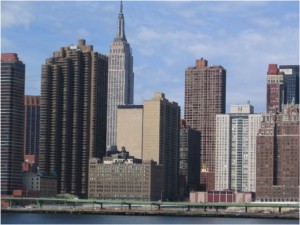
The Empire State Building, a National Historic Landmark, recently received LEED Gold certification under the LEED EB rating system.
It is well established that the construction and operations of buildings contribute almost 50% of all the greenhouse gas emissions in the United States — and making buildings more energy and resource efficient is one of the most immediate and measurable ways to address this growing concern. Since new and renovated high performing buildings, a growing number of which are LEED certified, comprise less than 10% of the country’s portfolio, it is clear that the biggest and indeed the most important way to improve our impact on the planet is to improve the operations of our existing buildings. Of the more than a dozen LEED rating systems, the only one to specifically address operations and maintenance is LEED EB:O&M (Existing Buildings: Operations & Maintenance).
And more and more, historic buildings of all sizes are recognizing that the best way to implement a whole building cyclical maintenance program which improves their efficiency and greens their activities is to adopt LEED EB:O&M.
LEED EB
Using LEED EB:O&M as a maintenance tool allows owners to integrate green strategies into an active program for the ongoing preventative maintenance and refurbishment of historic buildings. LEED EB:O&M’s continuous improvement cycle of “plan, implement, measure, assess” requires that once green strategies are implemented, certification will be based on tracking that performance over time. Performance periods must be continuous (three months to two years) and overlap. Certification under LEED EB:O&M is time sensitive and must be renewed at least every five years. Recertification encourages continuous monitoring and improvement of sustainable practices over time.
Although historic buildings that are receiving LEED certification for their capital renovations receive more press, some of the earliest buildings to certify under LEED EB:O&M have been historic buildings including the National Geographic complex in Washington, DC, the Colorado State Capitol in Denver and now the Empire State Building in New York. The synergies between a preservation cyclical maintenance program and improved environmental goals are encouraging the use of this rating system by all types and sizes of buildings. The first building in the world to achieve a triple LEED Platinum rating – LEED Core & Shell, LEED Commercial Interiors and now LEED EB:O&M is a historic building in Lansing, Michigan, the Christman Building. And now one of the first house museums to set LEED EB:O&M as a goal is the Haas-Lilienthal House in San Francisco, a Queen Anne style “painted lady” designed in 1886 and now operated as a house museum by San Francisco Architectural Heritage.
The Christman Building, Lansing, MI
The Christman Building is the world’s first triple-Platinum LEED certified project in the world. It received
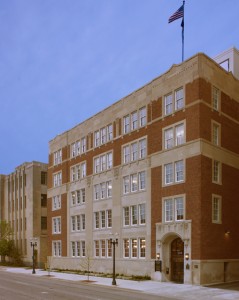
The Christman Building, listed in the National Register, is the first building in the world to receive triple platinum LEED ratings. Photo courtesy The Christman Company.
Platinum for LEED Commercial Interiors, v. 2 in 2008, LEED Core & Shell, v. 2.0 in 2008 and LEED EB: O &M in 2010.
This 1928 landmark, listed as the Mutual Building in the National Register of Historic Places and renamed The Christman Building in 2008 was a brownfield site in Lansing, Michigan, near the state capitol. The project is an excellent example of the potential of integrating historic preservation values with green building practices. It used both Rehabilitation Tax Credits and New Market tax credits. This grand old building’s new lease on life was accomplished through a commitment to sustainable, green, historic preservation at a cost no greater than conventional practices according to the owner.
The Christman Building and headquarters showcase the company’s integrated, sustainable and historic preservation construction capabilities, and its commitment to the environment and the community. Reuse of this historic building tapped the inherent embodied resources, avoided suburban sprawl and contributed to downtown revitalization. Its location utilizes existing public transportation and parking facilities. Showers and locker rooms encourage walking and bicycling to work. The white roof and reduced exterior lighting reduce heat island effects and light pollution. Energy use is reduced by task lighting, occupancy sensors, programmed timers in common areas, daylighting for 92% of occupants, high efficiency windows and Energy Star® office equipment and appliances. High efficiency HVAC systems provide individually controlled comfort conditions. The under floor air distribution system maximizes efficient, healthy ventilation. Low flow fixtures reduce water consumption by 40%. The design reused 92% of existing walls, roof and floors, and most of the company’s former office furnishings. Recycled and regionally manufactured materials, and low emission sealants, paints, carpets, and furniture were used extensively. All wood was FSC certified. The interior provides outdoor views to 90% of occupants. Workspaces were designed for flexibility, adaptability, collaboration and teamwork. Extensive recycling diverted 77% of construction debris from the landfill.
Colorado State Capitol, Denver CO (LEED EB:O+M)
The Colorado state Capitol was the first Capitol in the nation in 2008 to obtain certification for LEED EB (LEED Gold) for energy efficiency upgrades made over the past four years. The Capitol — built in 1895 — also has become the first building in the country to receive the U.S. Green Building Council’s new LEED certification for Existing Buildings: Operations & Maintenance.
The project received an Energy Star® score of 94 which is terrific for any building and incredible for a historic building and included using the thermal mass of the building to moderate temperatures. They have achieved a 27% water savings and 36% alternative commuting rates. Building specific improvements that have been made to the Capitol in order to obtain LEED-EB certification include:
- Water conservation efforts such as low flow toilets.
- Use of low energy light bulbs and T-8 light fixtures.
- Improved energy controls.
- Use of Green Seal green cleaning products.
- Initiation and maintenance of a recycling program.
- Purchase of Energy Star® electronics and equipment.
- Use of environmentally friendly landscaping products and plans.
National Geographic Headquarters, Washington, DC (LEED EB:O+M)
The National Geographic Society Headquarters is comprised of three structures dating from 1902, 1964 and
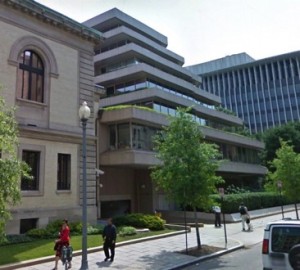
The National Geographic Headquarters, comprised of 3 buildings, was the first building to achieve a LEED EB rating. Photo courtesy Google.
1984. The 835,000 square foot building was the first to receive LEED EB certification under the USGBC’s Pilot Program, earning Silver certification in 2003. They recertified in 2009 at LEED Gold and this recertification makes the National Geographic Headquarters one of only of a handful of buildings to recertify under the LEED-EB program. Over the six years since the building’s initial certification, National Geographic Society has implemented continuous sustainability improvement measures guided by the LEED EB rating system.
The National Geographic Society implemented many green actions to achieve Gold recertification, including: (1) an extensive recycling program that has reduced waste disposal costs by 57% and $40,000; (2) a comprehensive alternative transportation and commuting program, including flexible schedules, telecommuting, bicycle racks, and preferred parking for carpools and hybrid vehicles; (3) fixture water use reduction 36% greater than LEED requirements; (4) an overhaul of the major mechanical systems that led to a 20% decrease in energy use; (5) use of native vegetation on the site and the roofs; and the use of rain sensors to reduce landscaping water use.
Empire State Building (LEED EB:O+M), New York, NY
The Empire State Building, the world’s most famous office building, has been awarded LEED Gold for existing buildings certification. Under a $550 million rebuilding program, the Empire State Building has become the tallest building in the US to receive LEED certification. The Empire State Building is one of the rare National Historic Landmarks to receive such certification. In addition to this certification, a 3,500-square-foot pre-built space on the 42nd floor has been certified Platinum under the LEED for Commercial Interiors.
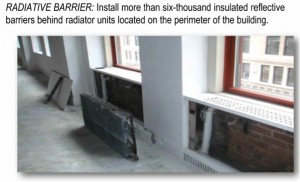
Retrofitting of the Empire State Buildings radiators was key to managing the energy use at this skyscraper. Image courtesy the Empire State Building website.
The Empire State building will reduce energy consumption by at least 38 percent, producing over $4.5 million in energy costs annually. This amount of savings allows an approximate three-year payback period of the cost of implementation. In addition to the LEED Gold certification, the Empire State Building has also maintained its Energy Star® certification received initially in 2010. The rebuilding effort will cut its overall carbon output, estimated in more than 100,000 metric tons over 15 years, through eight key initiatives:
- Window Light Retrofit– Refurbishment of approximately 6,500 thermopane glass windows converting them to triple pane windows. The building’s original steel windows were replaced with aluminum in the 1980s, and these were the windows that were refurbished.
- Radiator Insulation Retrofit -Heat loss was reduced by installing additional insulation behind building’s radiators.
- Tenant Lighting, Daylighting and Plug Upgrades-Improved lighting designs, daylighting controls, and plug load occupancy sensors.
- Air Handler Replacements-Replacement of air handling units with variable frequency drive fans.
- Chiller Plant Retrofit-Removing and replacing ‘guts’ to improve chiller efficiency and controllability.
- Whole-Building Control System Upgrade–Optimize HVAC operation, the recommended measures also reduce cooling load requirements by 33 percent (1,600 tons) and peak electrical demand by 3.5 megawatts.
- Ventilation Control Upgrade-Introduction of demand control ventilation in occupied spaces.
- Tenant Energy Management Systems -Introduction of individualized, web-based power usage systems for each tenant.
Some of the specific measures included:
- Reducing energy use and lowering greenhouse emissions.
- Producing savings in a verifiable way.
- Recommended the inclusion of improved design techniques and energy awareness among tenants.
- Provide replicability, resulting in an increase in multi-tenant building retrofits.
- Produced one of the most significant landmark ceiling restorations in the history of New York City.
- Installed energy efficient fixtures and bulbs that will adjust according to lighting needs and accordingly to the city’s energy demands.
- Large use of glass throughout the stores at street level to promote transparency and light.
- Use of green cleaning products.
- Use of ultra-low flow fixtures throughout Empire State’s restrooms.
- Establishing a waste and construction debris recycling program.
- Incorporating the use of recycled paper products.
- Including mandatory green requirements under new lease agreements.
- Using low off-gassing wall coverings, paints and adhesives.
For more detailed information on this story, see the Empire State Building’s website.
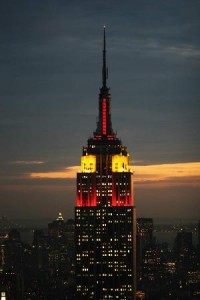
If the Empire State Building can achieve LEED EB Gold, so can your building! Photo courtesy Wikipedia.
A Lot of Firsts
Each of these projects labels itself a first or largest of some kind – first triple platinum, first to recertify, largestskyscraper in America to certify, possibly the first National Historic Landmark etc. Sadly, we’re still in that phase of design and green building where we need to point out the “firsts”. I do it as much as everyone, liking to proclaim that the Haas-Lilienthal House in San Francisco that I’m working on will be the “first house museum to be LEED certified.” But what this announcement from USGBC last week means is that we are quickly moving out of the “firsts” and heading into the “it’s common and expected practice.” We won’t save the world by building our new LEED Platinum and net zero buildings. The only way we will save the world from climate disaster is by managing our buildings better, whether they’re old or new. And LEED EB is one terrific tool to help us get there. I think of it as a cyclical maintenance plan on steroids.
And if you’d like to “subscribe” or follow this blog, True Green Cities, please sign up through the “Subscribe” button at the bottom left of this page. You’ll receive a daily recap when new blogs are posted.

